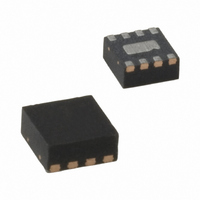MIC2287-24BML TR Micrel Inc, MIC2287-24BML TR Datasheet - Page 7

MIC2287-24BML TR
Manufacturer Part Number
MIC2287-24BML TR
Description
IC LED DRIVER WHITE BCKLGT 8-MLF
Manufacturer
Micrel Inc
Type
Backlight, White LEDr
Datasheet
1.MIC2287-24YML_TR.pdf
(10 pages)
Specifications of MIC2287-24BML TR
Constant Current
Yes
Topology
PWM, Step-Up (Boost)
Number Of Outputs
1
Internal Driver
Yes
Type - Primary
Backlight, Flash/Torch
Type - Secondary
White LED
Frequency
1.05MHz ~ 1.35MHz
Voltage - Supply
2.5 V ~ 10 V
Mounting Type
Surface Mount
Package / Case
8-MLF®, QFN
Operating Temperature
-40°C ~ 125°C
Current - Output / Channel
20mA
Internal Switch(s)
Yes
Lead Free Status / RoHS Status
Contains lead / RoHS non-compliant
Voltage - Output
-
Efficiency
-
Other names
MIC2287-24BMLTR
MIC2287-24BMLTR
MIC2287-24BMLTR
Dimming Control
There are two techniques for dimming control. One is PWM
dimming, and the other is continuous dimming.
Open-Circuit Protection
If the LEDs are disconnected from the circuit, or in case
an LED fails open, the sense resistor will pull the FB pin to
ground. This will cause the MIC2287 to switch with a high
duty-cycle, resulting in output overvoltage. This may cause
the SW pin voltage to exceed its maximum voltage rating,
possibly damaging the IC and the external components. To
ensure the highest level of protection, the MIC2287 has 3
product options in the 8-lead 2mm × 2mm MLF™ with over-
voltage protection (OVP). The extra pins of the 8-lead 2mm
× 2mm MLF™ package allow a dedicated OVP monitor with
July 2005
MIC2287
1. PWM dimming control is implemented by applying
2. Continuous dimming control is implemented by
a PWM signal on EN pin as shown in Figure 1. The
MIC2287 is turned on and off by the PWM signal.
With this method, the LEDs operate with either zero
or full current. The average LED current is increased
proportionally to the duty-cycle of the PWM signal.
This technique has high-efficiency because the IC
and the LEDs consume no current during the off
cycle of the PWM signal. Typical PWM frequency
should be between 100Hz and 10kHz.
applying a DC control voltage to the FB pin of the
MIC2287 through a series resistor as shown in
Figure 2. The LED intensity (current) can be dy-
namically varied applying a DC voltage to the FB
pin. The DC voltage can come from a DAC signal,
or a filtered PWM signal. The advantage of this ap-
proach is a high frequency PWM signal (>10kHz)
that can be used to control LED intensity.
V
IN
V
IN
Figure 1. PWM Dimming Method
Figure 2. Continuous Dimming
PWM
VIN
EN
GND
VIN
EN
SW
FB
GND
Equivalent
SW
FB
DC
49.9k
5.11k
7
options for 15V, 24V, or 34V (see Figure 3). The reason for
the three OVP levels is to let users choose the suitable level
of OVP for their application. For example, a 3-LED application
would typically see an output voltage of no more than 12V, so
a 15V OVP option would offer a suitable level of protection.
This allows the user to select the output diode and capacitor
with the lowest voltage ratings, as well as smallest size and
lowest cost. The OVP will clamp the output voltage to within
the specified limits. For the Thin SOT-23-5 package, an OVP
pin is not available. An external zener diode can be connected
from the output of the converter to FB pin as shown in Figure
4. to implement similar protection.
Start-Up and Inrush Current
During start-up, inrush current of approximately double the
nominal current flows to set up the inductor current and the
voltage on the output capacitor. If the inrush current needs
to be limited, a soft-start circuit similar to Figure 5 could be
implemented. The soft-start capacitor, C
drive to the FB pin at start-up, resulting in gradual increase
of switch duty cycle and limited inrush current.
Figure 4. Thin SOT-23 Package OVP Circuit
V
V
IN
IN
V
Figure 3. MLF™ Package OVP Circuit
IN
Figure 5. Soft-Start Circuit
VIN
EN
VIN
EN
GND
GND
VIN
EN
GND
SW
FB
SW
FB
OVP
SW
FB
2200pF
C
10k
SS
R
5.11k
SS
, provides over-
M9999-070105
Micrel, Inc.












